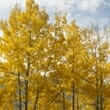Background
- Populus is a genus of trees that includes the cottonwoods, poplars, and aspens, all of which are sometimes termed poplars or popples. Most of the available scientific evidence has reported on aspen, and there are very few reports mentioning cottonwood.
- Aspen is a deciduous tree native to northern hemisphere temperate climates. Although aspen has shown antibacterial and antiplatelet activity, there is currently insufficient available evidence in humans to support the use of aspen for any indication.
- Aspen pollen, bark, wood, and saw dust are known to cause allergic reactions in sensitive people, including contact dermatitis, rhinoconjunctivitis, and asthma, and there may be cross-sensitivity to other tree pollens, especially in the Salicaceae family.
- The U.S. Food and Drug Administration (FDA) lists poplar buds (Populus balsamifera, P. candicans Ait., and P. nigra L.) as Generally Recognized as Safe (GRAS) for flavoring.
References
- Aalto-Korte K, Valimaa J, Henriks-Eckerman ML, et al. Allergic contact dermatitis from salicyl alcohol and salicylaldehyde in aspen bark (Populus tremula). Contact Dermatitis 2005;52(2):93-95.
View Abstract - Celik G, Mungan D, Pinar M, et al. Poplar pollen-related allergy in Ankara, Turkey: how important for patients living in a city with high pollen load? Allergy Asthma Proc 2005;26(2):113-119.
View Abstract - Eriksson NE, Wihl JA, Arrendal H, et al. Tree pollen allergy. III. Cross reactions based on results from skin prick tests and the RAST in hay fever patients. A multi-centre study. Allergy 1987;42(3):205-214.
View Abstract - Estlander T, Jolanki R, Alanko K, et al. Occupational allergic contact dermatitis caused by wood dusts. Contact Dermatitis 2001;44(4):213-217.
View Abstract - Faustova NM, Faustova ME, Deineko IP. [Antibacterial activity of aspen bark extracts against some pneumotropic microorganisms]. Zh.Mikrobiol.Epidemiol.Immunobiol. 2006;(3):3-7.
View Abstract - Ince A, Kart L, Demir R, et al. Allergenic pollen in the atmosphere of Kayseri, Turkey. Asian Pac.J Allergy Immunol 2004;22(2-3):123-132.
View Abstract - Jolanki R, Suhonen R, Henriks-Eckerman ML, et al. Contact allergy to salicyl alcohol in aspen bark. Contact Dermatitis 1997;37(6):304-305.
View Abstract - Kagawa K, Tokura K, Uchida K, et al. Platelet aggregation inhibitors from Populus sieboldii Miquel. Chem Pharm Bull.(Tokyo) 1992;40(8):2191-2192.
View Abstract - Thiede WH, Banaszak EF, Fink JN, et al. Hypersensitivity studies in popple (Aspen tree) peelers. Chest 1975;67(4):405-407.
View Abstract - Von Kruedener S, Schneider W, Elstner EF. A combination of Populus tremula, Solidago virgaurea and Fraxinus excelsior as an anti-inflammatory and antirheumatic drug. A short review. Arzneimittelforschung. 1995;45(2):169-171.
View Abstract - Yazicioglu M, Oner N, Celtik C, et al. Sensitization to common allergens, especially pollens, among children with respiratory allergy in the Trakya region of Turkey. Asian Pac.J Allergy Immunol 2004;22(4):183-190.
View Abstract







